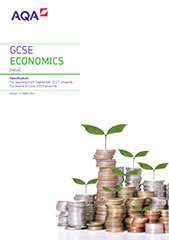3.2 How the economy works
Students are introduced to the wider economy from the perspective of the main economic groups: consumers, producers and government. Students explore the significance of interest rates including their impact on saving, borrowing and spending.
The core of this unit will focus on government objectives and their role in managing the economy. A range of policies will be explored in relation to the objectives, highlighting the fact that pursuing one objective can have a detrimental effect on other objectives.
Students also examine why countries trade, and the significance of the global economy, including free-trade agreements. Finally, students will explore the role of money and the significance of the financial markets in modern economies.
Students should be encouraged to explore the moral, ethical and sustainability issues that underpin all aspects of managing an economy.
Introduction to the national economy
Students explore how government spending and taxation can influence the level of economic activity. Interest rates will be introduced briefly in order to illustrate the effect on saving, borrowing and spending.
Interest rates, saving, borrowing, spending and investment
|
Content |
Additional information |
|---|---|
|
Students should be able to understand:
|
Government income and expenditure
Content |
Additional information |
|---|---|
|
Students should be able to understand:
|
Government objectives
Students study the principal economic objectives of stable prices, economic growth, full employment and the Balance of Payments. For each of the government objectives, students look at how they are measured, the factors that cause them and their implications, both positive and negative, for an economy. Students will learn that policies designed to achieve one of the objectives can often impact positively or negatively on achieving the other objectives.
Economic objectives of the government
Content |
Additional information |
|---|---|
|
Students should be able to understand:
|
Economic growth
Content |
Additional information |
|---|---|
|
Students should be able to understand:
|
Employment and unemployment
Content |
Additional information |
|---|---|
|
Students should be able to understand:
|
Inflation and price stability
Content |
Additional information |
|---|---|
|
Students should be able to understand:
|
Balance of payments
Content |
Additional information |
|---|---|
|
Students should be able to understand:
|
Distribution of income
Content |
Additional information |
|---|---|
|
Students should be able to understand:
|
How the government manages the economy
Students examine the tools available to government to manage the economy. Government economic policies will be looked at, with a focus on monetary, fiscal and supply-side policies. Each policy will be examined in turn to show how they can be used to influence economic performance. Government policies to affect the distribution of income and the correction of negative externalities are also addressed.
Fiscal policy
Content |
Additional information |
|---|---|
|
Students should be able to understand:
|
Monetary policy
Content |
Additional information |
|---|---|
|
Monetary policy |
Students should be able to understand:
|
Supply-side policies
Content |
Additional information |
|---|---|
|
Supply-side policies |
Students should be able to understand:
|
Policies to correct positive and negative externalities
Content |
Additional information |
|---|---|
|
Externalities |
Students should be able to understand government policies designed to influence positive and negative externalities. |
International trade and the global economy
Students look at why countries trade and the importance of international trade to the UK. The measurement of UK trade through the balance of trade is examined, as are the causes of current account surpluses and deficits within the overall balance of payments. Students consider how exchange rates are determined as well as the impact that changes in exchange rates have on producers and consumers. Students also explore the advantages of free-trade agreements, their impact and the significance of the European Union. The benefits and drawbacks of globalisation will be looked at, including the moral and ethical aspects associated with the increase in global trade, and the role of the multinational corporations.
Why countries trade and the importance of international trade to the UK
Content |
Additional information |
|---|---|
|
Students should be able to understand:
|
Exchange rates
Content |
Additional information |
|---|---|
|
Students should be able to understand how exchange rates are determined through the interaction of demand and supply. |
Free-trade agreements including the European Union
Content |
Additional information |
|---|---|
|
Students should be able to understand:
|
Globalisation: benefits and drawbacks
Content |
Additional information |
|---|---|
|
Students should be able to understand:
|
The role of money and financial markets
Students look at the role of money, its functions and the role and importance of the financial markets. The importance to consumers, producers and government with respect to saving, borrowing and spending will be examined.
The role of money
Content |
Additional information |
|---|---|
|
Students should be able to understand:
|
The role and importance of the financial sector for the economy
Content |
Additional information |
|---|---|
|
Students should be able to understand:
|
